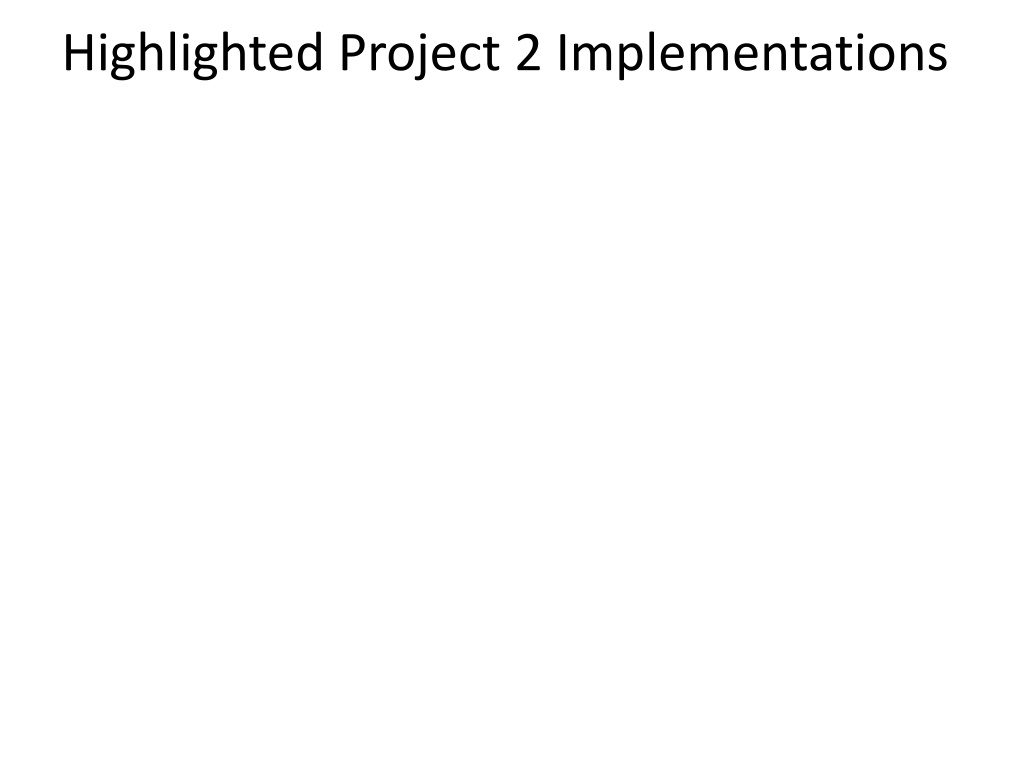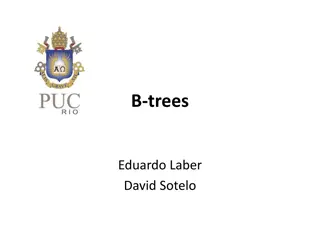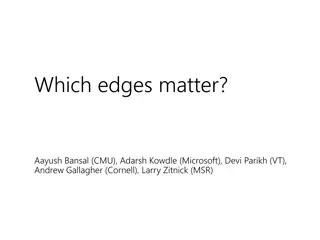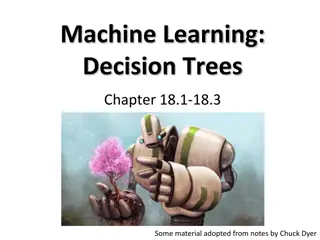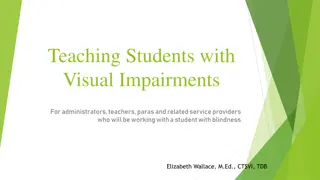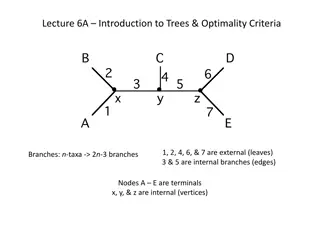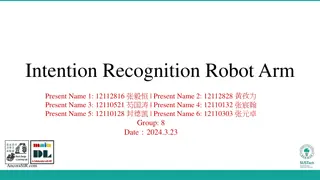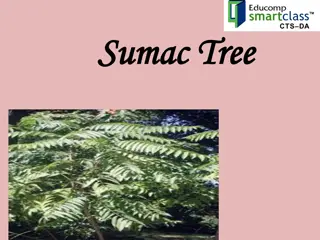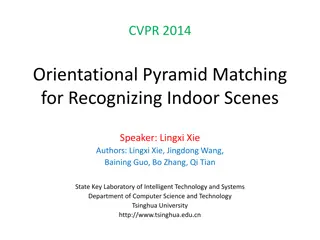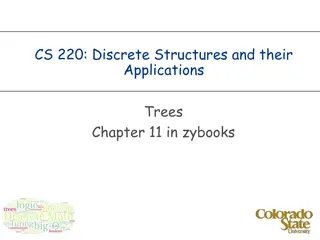Exploring Visual Vocabulary Trees for Image Recognition
In this detailed content, the implementation of Vocabulary Trees for image recognition is discussed. The structure's complexity, efficiency in processing a large number of images, and issues related to instance recognition are explored. The text delves into the benefits of using vocabulary trees, challenges in forming optimal vocabularies, and questions surrounding spatial agreement and scoring retrieval results in image recognition tasks.
Download Presentation

Please find below an Image/Link to download the presentation.
The content on the website is provided AS IS for your information and personal use only. It may not be sold, licensed, or shared on other websites without obtaining consent from the author. Download presentation by click this link. If you encounter any issues during the download, it is possible that the publisher has removed the file from their server.
E N D
Presentation Transcript
Vocabulary trees: complexity Number of words given tree parameters: branching factor and number of levels branching_factor^number_of_levels Word assignment cost vs. flat vocabulary O(k) for flat O(logbranching_factor(k) * branching_factor) Is this like a kd-tree? Yes, but with better partitioning and defeatist search. This hierarchical data structure is lossy you might not find your true nearest cluster.
110,000,000 Images in 5.8 Seconds Slide Slide Credit: Nister
Slide Slide Credit: Nister
Slide Slide Credit: Nister
Slide Slide Credit: Nister
Higher branch factor works better (but slower)
Visual words/bags of words + flexible to geometry / deformations / viewpoint + compact summary of image content + provides fixed dimensional vector representation for sets + very good results in practice - background and foreground mixed when bag covers whole image - optimal vocabulary formation remains unclear - basic model ignores geometry must verify afterwards, or encode via features Kristen Grauman
Instance recognition: remaining issues How to summarize the content of an entire image? And gauge overall similarity? How large should the vocabulary be? How to perform quantization efficiently? Is having the same set of visual words enough to identify the object/scene? How to verify spatial agreement? How to score the retrieval results? Kristen Grauman
Can we be more accurate? So far, we treat each image as containing a bag of words , with no spatial information Which matches better? h e z a f e h a f e e
Can we be more accurate? So far, we treat each image as containing a bag of words , with no spatial information Real objects have consistent geometry
Spatial Verification Query Query DB image with high BoW similarity DB image with high BoW similarity Both image pairs have many visual words in common. Slide credit: Ondrej Chum
Spatial Verification Query Query DB image with high BoW similarity DB image with high BoW similarity Only some of the matches are mutually consistent Slide credit: Ondrej Chum
Spatial Verification: two basic strategies RANSAC Typically sort by BoW similarity as initial filter Verify by checking support (inliers) for possible transformations e.g., success if find a transformation with > N inlier correspondences Generalized Hough Transform Let each matched feature cast a vote on location, scale, orientation of the model object Verify parameters with enough votes Kristen Grauman
Recall: Fitting an affine transformation Approximates viewpoint changes for roughly planar objects and roughly orthographic cameras. ( , ) iy x i iy x i ( , ) m 1 m 0 x 2 i i x m m x 0 1 0 t m x 0 y 0 3 i i 1 2 = 1 i = + i i 0 1 m x y y y m m y t 4 i i 3 4 2 i t 1 t 2
Instance recognition: remaining issues How to summarize the content of an entire image? And gauge overall similarity? How large should the vocabulary be? How to perform quantization efficiently? Is having the same set of visual words enough to identify the object/scene? How to verify spatial agreement? How to score the retrieval results? Kristen Grauman
Scoring retrieval quality Results (ordered): Database size: 10 images Relevant (total): 5 images Query precision = #relevant / #returned recall = #relevant / #total relevant 1 0.8 precision 0.6 0.4 0.2 0 0 0.2 0.4 0.6 0.8 1 recall Slide credit: Ondrej Chum
What else can we borrow from text retrieval? China is forecasting a trade surplus of $90bn ( 51bn) to $100bn this year, a threefold increase on 2004's $32bn. The Commerce Ministry said the surplus would be created by a predicted 30% jump in exports to $750bn, compared with a 18% rise in imports to $660bn. The figures are likely to further annoy the US, which has long argued that China's exports are unfairly helped by a deliberately undervalued yuan. Beijing agrees the surplus is too high, but says the yuan is only one factor. Bank of China governor Zhou Xiaochuan said the country also needed to do more to boost domestic demand so more goods stayed within the country. China increased the value of the yuan against the dollar by 2.1% in July and permitted it to trade within a narrow band, but the US wants the yuan to be allowed to trade freely. However, Beijing has made it clear that it will take its time and tread carefully before allowing the yuan to rise further in value. China, trade, surplus, commerce, exports, imports, US, yuan, bank, domestic, foreign, increase, trade, value
tf-idf weighting Term frequency inverse document frequency Describe frame by frequency of each word within it, downweight words that appear often in the database (Standard weighting for text retrieval) Total number of documents in database Number of occurrences of word i in document d Number of documents word i occurs in, in whole database Number of words in document d Kristen Grauman
Query expansion Query: golf green Results: - How can the grass on the greens at a golf course be so perfect? - For example, a skilled golfer expects to reach the green on a par-four hole in ... - Manufactures and sells synthetic golf putting greens and mats. Irrelevant result can cause a `topic drift : - Volkswagen Golf, 1999, Green, 2000cc, petrol, manual, , hatchback, 94000miles, 2.0 GTi, 2 Registered Keepers, HPI Checked, Air-Conditioning, Front and Rear Parking Sensors, ABS, Alarm, Alloy Slide credit: Ondrej Chum
Query Expansion Results Spatial verification Query image New results Chum, Philbin, Sivic, Isard, Zisserman: Total Recall , ICCV 2007 New query Slide credit: Ondrej Chum
Recognition via alignment Pros: Effective when we are able to find reliable features within clutter Great results for matching specific instances Cons: Spatial verification as post-processing not seamless, expensive for large-scale problems Not suited for category recognition. Kristen Grauman
Summary Matching local invariant features Useful not only to provide matches for multi-view geometry, but also to find objects and scenes. Bag of words representation: quantize feature space to make discrete set of visual words Summarize image by distribution of words Index individual words Inverted index: pre-compute index to enable faster search at query time Recognition of instances via alignment: matching local features followed by spatial verification Robust fitting : RANSAC, GHT Kristen Grauman
Lessons from a Decade Later For Category recognition (project 4) Bag of Feature models remained the state of the art until Deep Learning. Spatial layout either isn't that important or its too difficult to encode. Quantization error is, in fact, the bigger problem. Advanced feature encoding methods address this. Bag of feature models are nearly obsolete. At best they seem to be inspiring tweaks to deep models e.g. NetVLAD. James Hays
Lessons from a Decade Later For instance retrieval (this lecture) deep learning is taking over. learn better local features (replace SIFT) e.g. MatchNet or learn better image embeddings (replace the histograms of visual features) e.g. Vo and Hays 2016. or learn to do spatial verification e.g. DeTone, Malisiewicz, and Rabinovich 2016. or learn a monolithic deep network to recognition all locations e.g. Google s PlaNet 2016. James Hays
